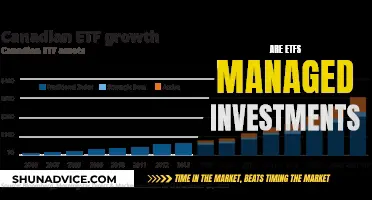
The Thrift Savings Plan (TSP) is a retirement savings and investment plan for federal employees and members of the military. It is similar to a 401(k) plan, with tax benefits and the option to have contributions taken directly from paychecks. The TSP offers a choice of six funds and a mutual fund option, including the Government Securities Investment (G) Fund, the Fixed Income Index Investment (F) Fund, the Common-Stock Index Investment (C) Fund, the Small-Capitalization Stock Index Investment (S) Fund, the International-Stock Index Investment (I) Fund, and Lifecycle (L) Funds.
| Characteristics | Values |
|---|---|
| Who is eligible? | Federal employees and members of the military |
| Type of plan | Defined contribution retirement savings and investment plan |
| Similarity | 401(k) plan |
| Tax benefits | Yes |
| Number of individual fund options | 5 |
| Investment options | U.S. Treasury securities, bonds, U.S. or international stocks |
| Funds | G Fund (Government Securities Investment Fund), F Fund (Fixed Income Index Investment Fund), C Fund (Common Stock Index Investment Fund), S Fund (Small Cap Stock Index Investment Fund), I Fund (International Stock Index Investment Fund) |
| Contribution limit | $23,000 for 2024; $7,500 extra for those over 50 |
| Rollover | Allowed |
| Administration costs | Low |
| Investment fees | Low and transparent |
| Withdrawal options | Monthly, quarterly, or annually |
What You'll Learn

Government Securities Investment Fund (G Fund)
The Government Securities Investment Fund (G Fund) is a low-volatility, virtually risk-free US bond fund. It is one of the five individual fund options available under the Thrift Savings Plan (TSP), a retirement savings and investment plan for federal employees and members of the military.
The G Fund is invested in short-term US Treasury securities specially issued to the TSP. The payment of principal and interest is guaranteed by the US government, so there is no credit risk. The G Fund's investment objective is to ensure the preservation of capital and generate returns above those of short-term US Treasury securities.
The G Fund is a good option for investors who want a portion of their retirement account to be completely protected from loss. It is a stable and secure investment, but it may not provide significant growth over time. The G Fund is subject to inflation risk, meaning that the investment may not grow enough to offset the reduction in purchasing power caused by inflation.
The G Fund has historically outperformed 3-month US Treasury Bills and commercial money market funds. While it is not guaranteed to outpace inflation, it did so between its inception and 2010 by a significant margin. However, due to historically low-interest rates and unprecedented Fed stimulus, the G Fund no longer outpaces inflation as of 2020.
The G Fund is a popular choice for TSP participants, with millions of investors holding almost $300 billion in investments as of January 2024. It is also included in the Lifecycle or "L Funds," which hold a portion of their investments in the G Fund along with the other four main TSP funds.
How Interest Rates Affect Savings and Investments
You may want to see also

Fixed Income Index Investment Fund (F Fund)
The Fixed Income Index Investment Fund (F Fund) is one of the individual funds offered by the Thrift Savings Plan (TSP). The F Fund is a broadly diversified US bond index fund, designed to match the performance of the Bloomberg US Aggregate Bond Index, a broad index representing the US bond market.
The F Fund is invested in an index fund that tracks the Bloomberg US Aggregate Bond Index, which consists of high-quality, fixed-income securities with maturities of more than one year. The fund includes only investment-grade securities, which means that the overall risk is relatively low compared to certain other fixed-income investments in the market. The F Fund provides broad exposure to US investment-grade bonds, investing about 30% in corporate bonds and 70% in US government bonds of all maturities.
The F Fund is well-suited for investors seeking a diversified portfolio with a conservative investment strategy. Fixed-income securities are considered to have lower returns and lower risk than stocks, making them a safer investment option. The F Fund is also a good choice for investors looking to earn higher rates of return over the long term compared to short-term securities such as the G Fund.
However, it is important to note that the F Fund is subject to market and inflation risk. F Fund returns are closely tied to the returns in the bond market, and investors are exposed to the possibility of credit default risk and inflation risk. Additionally, the F Fund investments may not always outperform or grow enough to offset the reduction in purchasing power due to inflation.
The F Fund can be a valuable component of a retirement portfolio, especially when combined with stock funds like the C, S, and I Funds offered by the TSP. By including the F Fund in a retirement portfolio, investors can benefit from the relatively lower volatility compared to portfolios that contain only stock funds.
Transferring Funds: Ally Invest to Ally Savings
You may want to see also

Common Stock Index Investment Fund (C Fund)
The Common Stock Index Investment Fund (C Fund) is one of the five individual fund options available under the Thrift Savings Plan (TSP). The TSP is a retirement savings and investment plan for federal employees and members of the military.
The C Fund is a US stock index fund that tracks the Standard & Poor's 500 (S&P 500) Index, a broad market index made up of the stocks of 500 large to medium-sized US companies. The fund's objective is to match the performance of the S&P 500 Index, which covers about 75% of the US stock market's value. The S&P 500 Index is designed to provide a representative measure of US stock market performance. The C Fund is passively managed and remains fully invested during all market cycles and economic conditions.
The C Fund offers investors the opportunity to gain from the potential growth of the US economy and corporate profits, which is eventually reflected in increasing stock prices and dividends. The fund has historically provided good inflation hedging, although there is no guarantee that this will continue in the future. The C Fund can be a useful part of a portfolio that also contains stock funds tracking other indexes, such as the S Fund and the I Fund, as well as bond funds like the F Fund. This diversification can help to reduce exposure to market risk and lower the overall volatility of the investment portfolio.
As of 31 December 2023, the C Fund had assets of $339 billion, with an expense ratio of 0.048%. The fund's top holdings included Microsoft Corporation, Alphabet Inc. (Class A and Class C), Meta Platforms Inc Class A, and Berkshire Hathaway Inc Class B.
The PVF Savings Investment: A Smart Financial Move
You may want to see also

Small-Cap Stock Index Investment Fund (S Fund)
The Small-Cap Stock Index Investment Fund (S Fund) is one of the five individual investment funds available under the Thrift Savings Plan (TSP). The S Fund's investment objective is to match the performance of the Dow Jones U.S. Completion Total Stock Market Index, which is a broad market index made up of stocks of small-to-medium U.S. companies not included in the S&P 500 Index.
The S Fund provides investors with the opportunity to experience gains from equity ownership of small-to-mid-sized U.S. companies, while also diversifying their domestic equity holdings. As of 2021, there are approximately 3,300 stocks in this index.
The S Fund carries market and inflation risk. There is a risk of loss if the Dow Jones U.S. Completion TSM Index declines due to changes in overall economic conditions (market risk) or if S Fund investments do not outpace inflation (inflation risk).
The S Fund can be a useful addition to a portfolio that contains other stock funds that track different indexes, such as the C Fund and the I Fund. By investing in all segments of the stock market, investors can reduce their exposure to market risk.
The S Fund has a low expense ratio of 0.079% as of December 31, 2023, and its performance is evaluated based on how closely its returns match those of the Dow Jones U.S. Completion TSM Index.
The S Fund is passively managed, meaning it remains fully invested during all market cycles and economic conditions. While stocks have historically been a good hedge against inflation, there is no guarantee that the S Fund will always outperform inflation.
Investing in the S Fund provides an opportunity to benefit from the potential growth of the U.S. economy and corporate profits, which can lead to increasing stock prices and dividends.
Saving and Investing: Biblical Principles for Financial Wisdom
You may want to see also

International Stock Index Investment Fund (I Fund)
The International Stock Index Investment Fund (I Fund) is one of the individual funds offered by the Thrift Savings Plan (TSP). The TSP is a retirement savings and investment plan for federal employees and members of the military.
The I Fund offers investors the opportunity to gain exposure to stocks of large, medium, and small companies in over 40 developed and emerging market countries (excluding the US). As of July 31, 2024, the I Fund's benchmark index is the MSCI ACWI IMI ex USA ex China ex Hong Kong Index, which includes over 5,000 stocks across 44 countries. The fund's objective is to match the performance of this index.
The I Fund is a good option for those looking to diversify their TSP portfolio. By investing in international stocks, investors can reduce their exposure to market risk, as the prices of domestic and international stock markets don't always move in tandem. The I Fund can be particularly useful when combined with other stock funds, such as the C Fund and the S Fund, as well as bond funds like the F Fund.
It's important to note that the I Fund is subject to market and inflation risk. Its returns are influenced by the performance of the MSCI ACWI IMI ex USA ex China ex Hong Kong Index and currency fluctuations. Additionally, there is no guarantee that investments in the I Fund will keep pace with inflation.
As of November 1, 2024, the TSP I Fund had a compound annual growth rate of 5.9%, an annualized standard deviation of 17.6%, and a Sharpe Ratio of 0.18. An initial investment of $1,000 on August 31, 1990, would be worth $6,992 as of November 1, 2024.
Savings vs Investment: Imbalance and its Impact
You may want to see also
Frequently asked questions
The Thrift Savings Plan (TSP) is a retirement savings and investment plan for federal employees and members of the military.
The TSP offers five different individual fund options, each one invested in either U.S. Treasury securities, bonds, or U.S. or international stocks.
The five core funds are the Government Securities Investment (G) Fund, the Fixed Income Index Investment (F) Fund, the Common Stock Index Investment (C) Fund, the Small Capitalization Stock Index Investment (S) Fund, and the International Stock Index Investment (I) Fund.
The TSP offers tax advantages, low administrative costs, and the potential for matching contributions from the government.
Participants can contribute a percentage of their basic pay each pay period, which is automatically deducted and invested in their chosen TSP fund options.







